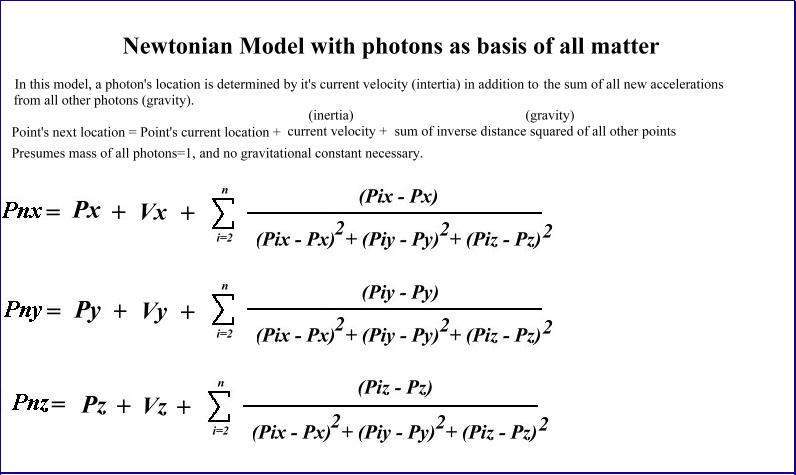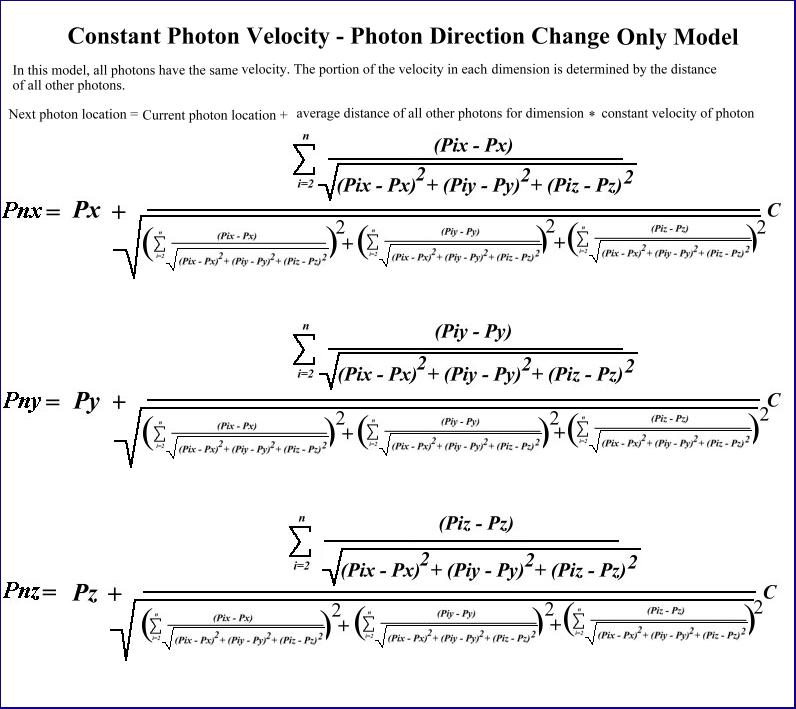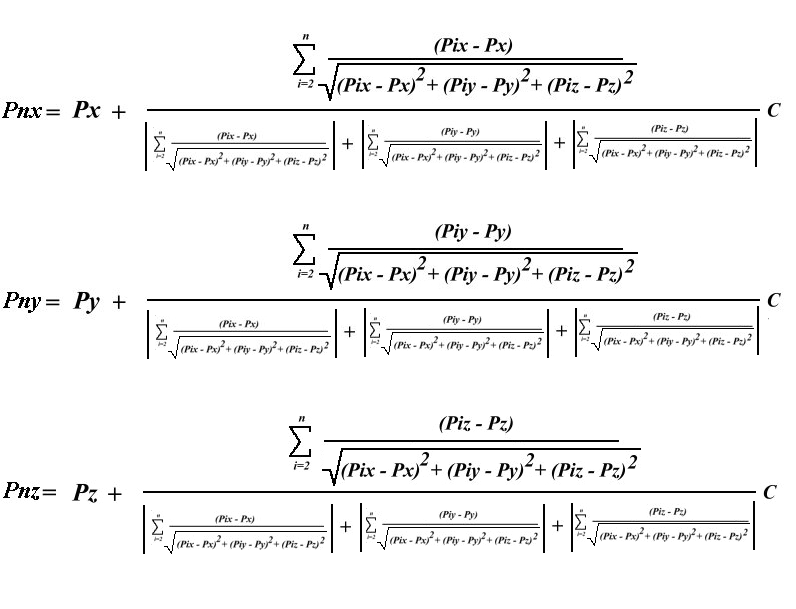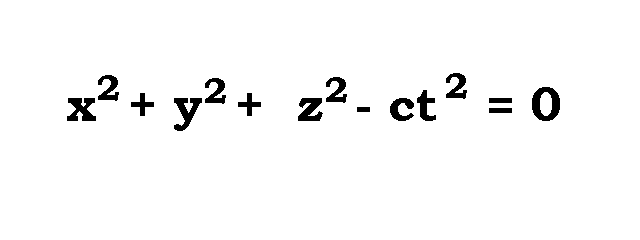In learning basic physics, one of the first lessons humans learn is to model matter moving under the force of gravity. Using the simple equation Isaac Newton first wrote F= K*m1*m2/d2 where F is the force of gravity between two pieces of matter, K is the gravitational constant, m1 and m2 are the masses of two pieces of matter. This equation is used in the arcade game "Lunar Lander" and "Space War" (in the era of "Pong" and "Space Invaders").
Most people have replaced or changed the current models of moving matter to the "General Theory of Relativity" and "Quantum Mechanics". I have to admit that I have not found enough information on how to model a piece of matter with the General Theory of Relativity or with Quantum Mechanics, but am actively interested in doing that. I am relatively certain that modeling matter using the Newton equation is easier than modeling matter with General Relativity or Quantum Mechanics.
While thinking of the universe and the interesting fact that light (photons) moves with a constant velocity of 2.99e8 meters each second, I got the exciting idea of modeling particles that move with a constant velocity. One problem with this idea is that in the Newton model, the force of gravity changes the velocity of each particle. I need to have the particles stay at the same velocity. I realized that if I simply changed the direction of each particle (not the velocity) I could model a pretend universe where the particles changed the direction of each other, but not the velocity of any particle. In this kind of universe, the particles could actually orbit each other (constantly change direction) while maintaining a constant velocity.
When I initially modeled this "particles with constant velocity" universe, I had to spend some time trying to get the particles from collapsing to a densely packed sphere. What happens at the scale I am using, and with an inverse distance squared relation is that the "cube" of points I start with collapses in to tiny points that slowly collapse in to a center. I see that particles that only change the direction of each other can only move "out" from the center as far as the farthest particle. In other words, no particle would move left if there were no other particles on the left.
Although the original model is interesting, one answer I thought of was to have each particle only change part of the direction of each other. In this way the particle would have a "momentum" of direction. A new influence would only partly change the direction. The direction the particle was originally moving in will have more value. I seriously doubt a universe would be that complex, or have a special condition, but I am still developing these models and this is for a pretend universe anyway. I think that if enough points are used and let to move for enough time, one particle would have a smaller influence on other particles. This is one problem that no human has 15 billion years to wait and see if the model is accurate for the first 15 billion years of the universe!
I have listed part of the computer program to model this type of universe, written in C, below. In this code, the variable "direk2" defines how much of the original direction is weighted versus the new direction. This number can be 1.0 to 0.0. At 0.0 the location of other particles completely define the direction of each particle. For this model, the particles may change directions in a picosecond, moving from 90 degrees (right) to 270 degrees (left), the direction the particle was moving in the past has no influence on the direction of the particle now.
The number of points used makes almost no difference in my experience. The points appear to move in the same patterns at any scale.
The variable "cveloc" is the constant velocity each point must move. If I use 1.0 (as is used for the movie), then a point could have a change in direction of:
a: -0.5
b: 0.3
d: -0.2
[This is for an (a,b,d) triordinate system. People can use an (x,y,z) system. I use (a,b,d) because I think the letter x may fall to the past, not having a unique sound.]
No matter what direction the point moves in, the absolute values of the change in location must always equal 1.0, as you can see here [0.5 + 0.3 + 0.2 = 1.0].
Please have fun with the code and freely copy anything you want to. I have enjoyed myself viewing a variety of the results of modeling particles that move at constant velocity.
Ted Huntington
Here is the part of the code included with this article that calculates the change in direction for each particle:
//calculations/equations to model photons (or any piece of matter) moving with constant velocity
//perhaps this could be done geometrically in a 4 or 2 dimension space-time.
//This view would have time as being constant throughout the universe, and not unique for each piece of matter.
//One interesting question, and one of the first questions that is asked is in a universe where all matter is made of photons is: "How can the charge of a particle like an electron be explained?"
//I do not have any videos that explain this, but my initial guess is that an electron may be a group of trillions of photons,
//Ultimately, in this universe view, matter moves in the direction of the most matter, most close. So there are two principles that are involved: 1) how close other photons are, and 2) how many other photons there are. For example, if a group of 100 photons is 1000 location units (pixels) away from a photon, a photon only 10 pixels away may change the direction of the photon more than the group of 100 photons. One explanation is the timing of the matter in particles like electrons as opposed to neutrons. In electrons, the particles may be at the same relative location every femtosecond, where in a neutron the particles may not have a repeated location or pattern. If a photon is in some particular location (relative to the center of an electron) at a regular interval, the attraction to other groups of photons moving with the same interval would be more than the neutron group of photons. Another possible explanation (to also include opposite/electrical-magnetic repulsion) is that electron (photon groups) orbit a group of matter (also photons) out to a certain distance in a clockwise (or counterclockwise depending on your location) rotation. The appearance of electrical/magnetic repulsion is the problem of moving matter with electrons orbiting the opposite direction in to the stream of photons moving around the other piece of matter. I am interested in hearing ideas from other people on the problem of photons causing electromagnetic attraction and repulsion. Because this may be difficult to explain, is no reason to abandon the theory that the universe is filled with one kind of piece of matter and one physical "force" or physical explanation. Like all science, time will reveal what the most accurate and useful products and ideas are. Like all science, time will reveal what the most accurate and useful products and ideas are.
//One other point I want to add is that the amount of change or influence in direction one photon may have on a different photon has never been measured as far as I have ever seen and may be a difficult quantity to measure. Perhaps this quantity is related by inverse square of distance or by some other relationship.
void move_points(void)
{ //procedure to move points each frame (or time unit)
float dist,dist2;
float da,db,dd;
float denom,denom2;
for (a=0;a<numpoints;a++)
{
v2[a].a = 0;
v2[a].b = 0;
v2[a].d = 0;
for (b=0;b<numpoints;b++)
{
if (b != a) //do not compare point with itself
{
//calulate distance between two points
//calculate da,db,dd (traditionally dx,dy,dz)
da = p[b].a - p[a].a;
db = p[b].b - p[a].b;
dd = p[b].d - p[a].d;
dist = da*da+db*db+dd*dd;
dist = pow(dist,0.5);
dist = pow(dist,dexp);
//for now, I am experimenting with an integer (only) space
if (dist < 1.0) {dist = 1.0;}
//sum each normalized influence (for example .1 .2 .7 = 1.0)
//of all pieces of matter on 1 piece
//this final velocity (or change in location)
//will be > 1.0 because the influences of all the points
//(relative to their inverse squared [or inverse, or inverse square rooted]
//distances) are added
denom=fabs(da)+fabs(db)+fabs(dd);
if (denom==0) {denom=1.0;} //avoid division by zero
v2[a].a = v2[a].a + (da / denom)/dist;
v2[a].b = v2[a].b + (db / denom)/dist;
v2[a].d = v2[a].d + (dd / denom)/dist;
//more distance between 2 photons = less influence
} //end if different photons/or particles with constant velocity
} //end for b
} //end for a
for (a=0;a<numpoints;a++)
{
//divide the added change in location/velocity of each photon by number of points
//photons should have the same influence on each other
//this number could be measured by measuring how much one photon changes direction
//compared to a different photon - although this may be difficult to measure
v2[a].a/=numpoints;
v2[a].b/=numpoints;
v2[a].d/=numpoints;
//normalize normalized sum of influences for final overall influence =
// (a + b + d = 1.0) 1.0 is the velocity the photon must move (divided in 3 dimensions)
denom=fabs(v2[a].a) + fabs(v2[a].b) + fabs(v2[a].d);
//if this part was not included, the photons (or particles of matter) would have
//no possibility of going past each other and occupy each space in a sphere
//this provides a kind of "momentum" of direction, perhaps there is some way around this
//current direction has more effect than new direction
denom2=(1-direk)*denom+direk*(fabs(v[a].a) +fabs(v[a].b) +fabs(v[a].d));
if (denom2==0) {denom2=1.0;}
denom2/=cveloc; //will make base velocity = cveloc
//take some part of the current velocity and the new velocity
//normalized for a third time to = 1.0
v[a].a = (direk*v[a].a+(1-direk)*v2[a].a)/denom2;
v[a].b = (direk*v[a].b+(1-direk)*v2[a].b)/denom2;
v[a].d = (direk*v[a].d+(1-direk)*v2[a].d)/denom2;
//finally, add change in location to each point
p[a].a = p[a].a + v[a].a;
p[a].b = p[a].b + v[a].b;
p[a].d = p[a].d + v[a].d;
} //end for a
}
07/24/2013: I am moving these notes off of my main "papers" page and relocating them to here.



